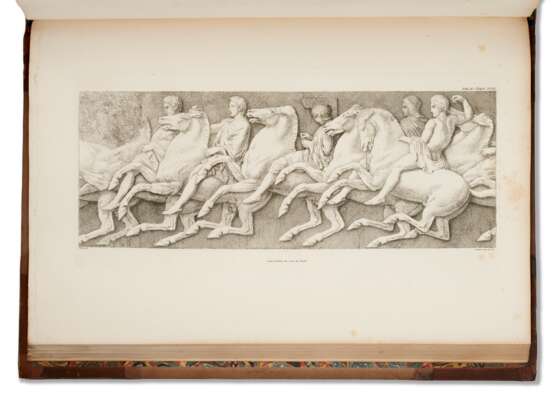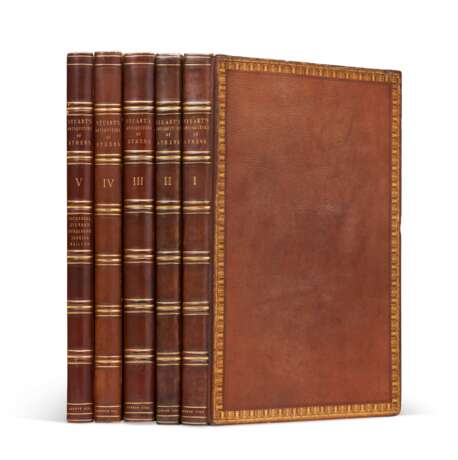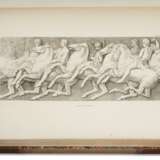ID 627532
Lot 42 | The Antiquities of Athens
Estimate value
$ 8 000 – 12 000
“The source book for the later Greek revival in England” (Fowler), and with important provenance. Stuart and Revett traveled to Greece in 1750 to make the drawings which would eventually become this work, published in four volumes plus supplement over the course of nearly seventy years. This work was the first scholarly survey on Greece of its kind—and is also the first published work to discuss polychromy in Greek sculpture. It was narrowly beat to press by Le Roy's Les Ruines des plus beaux Monuments de la Grèce, sparking a rather bitter enmity. The book's arduous publication history was satirized by William Hogarth, who mocked it with his engraving Five Orders of Periwigs...to be Published in about 17 Years. Four plates in volume three were executed by William Blake, then apprenticed to engraver James Basire. RIBA 3183-7; Fowler 340; Cicognara 2713.
Five volumes, folio (535 x 365mm). Errata leaves in vol. 1 and 3; 2 engraved portrait frontispieces (portrait of Stuart in vol 1, as often with later issues); 371 engraved plates, some folding or double-page, including the maps and two portraits, one of the folding maps hand-colored in outline; many engraved vignettes and in-text illustrations (variable toning and foxing, lacking pl.X.6 in vol. 3 but chapter IX with an additional unnumbered map, about 30 leaves towards the end of vol. 4 with dampstain to bottom margin, f.f.e. and portrait detached in vol. 1). First three volumes in contemporary straight-grained morocco gilt, all edges gilt, the others in half calf, all five uniformly rebacked in morocco gilt (light rubbing to joints, some light shipping/drying to corners and edges). Provenance: George John Vulliamy (1817-1886, British architect, designer of the lamp posts on the Thames Embankment; armorial bookplates) – Arthur Hamilton Smith (1860-1941, Keeper of Greek and Roman Antiquities at the British Museum from 1909 to 1925).
| Artist: | William Shakespeare (1564 - 1616) |
|---|---|
| Applied technique: | Pencil |
| Artist: | William Shakespeare (1564 - 1616) |
|---|---|
| Applied technique: | Pencil |
| Address of auction |
CHRISTIE'S 8 King Street, St. James's SW1Y 6QT London United Kingdom | |
|---|---|---|
| Preview |
| |
| Phone | +44 (0)20 7839 9060 | |
| Buyer Premium | see on Website | |
| Conditions of purchase | Conditions of purchase |













